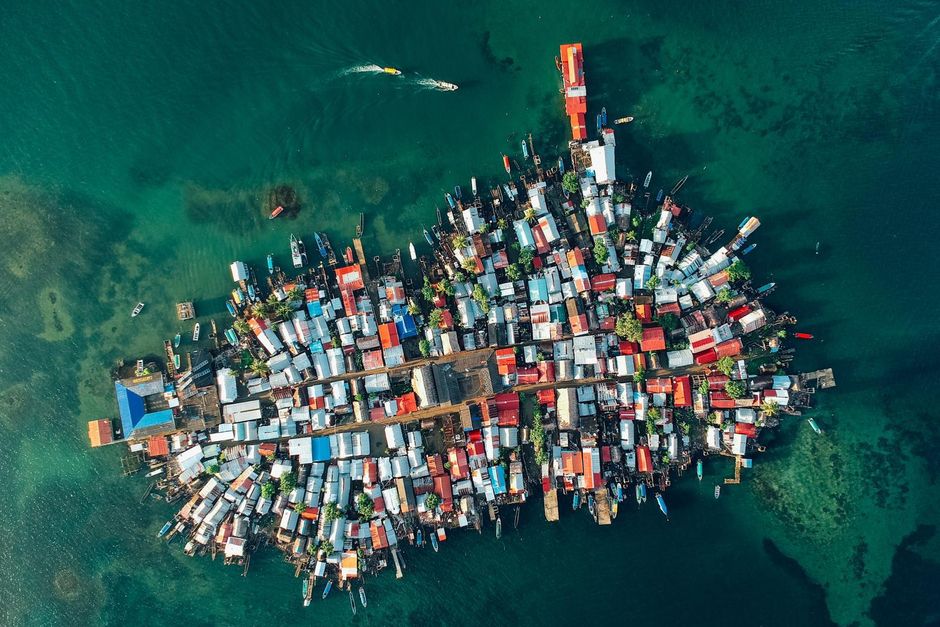GARDI SUGDUB, Panama—From this tiny, hot and overcrowded island, some 1,200 indigenous Guna people will soon embark on a short but historic exodus.
Next year, most inhabitants of Gardi Sugdub—the name means Crab Island—will leave the cluster of thatched and tin-roofed houses traversed by narrow footpaths where they have lived for more than a century, and head for the Panamanian mainland about a mile away.
These indigenous people will become the first residents in Latin America to be moved pre-emptively by their government from an island whose fate scientists say is to be swallowed by the sea in coming decades due to rising tides caused by climate change.
“When the tide goes up, the water enters some houses and the people have to move their belongings to higher ground,” said Pragnaben Mohan, who teaches computer science at the grade school on the island. The water even reaches one of the school’s classrooms, so that professors and students must use rubber boots to get in, she said.
The move is scheduled for late next year. On terra firma, they will exchange their island homes of reed walls and sand floors for modern two-bedroom prefab houses in a new neighborhood of some 300 homes called La Barriada, which looks like a small suburban Florida subdivision. The move, pushed by the Guna community on the island and agreed to by the Panamanian government, has been in the works for more than a decade. La Barriada is about 70 percent built.

Gardi Sugdub is one of 365 islands in the San Blas archipelago, about 39 of which are settled by about 30,000 Guna, members of a fiercely independent people who arrived on the islands more than a century-and-a-half ago from the Colombian and Panamanian mainland, fleeing malaria and yellow fever, according to historians. There are 10 more Guna villages on the mainland.
Tourism, the mainstay of the local economy, is rudimentary. About 100 cabins, most with thatched roofs and reed walls, are spread among the islands for the few thousand visitors who stay overnight during the year and buy Molas, the colorful textiles that the Guna weave. Only Guna families are allowed to participate in tourism.
Some of the San Blas Islands are as densely populated as Gardi Sugdub, but most are deserted spits of sand with coconut palms floating on azure waters. Most sit just 2 to 3 feet above sea level.
In the archipelago, sea-level rise has accelerated from about 1 millimeter a year in the 1960s to about 3.5 millimeters annually at present, according to tide-gauge data from the Panama Canal Authority and satellite data from the U.S. National Oceanic and Atmospheric Administration.
Sooner or later, most of the San Blas Islands will be uninhabitable, said Steven Paton, the director of the physical monitoring program at the Smithsonian Tropical Research Institute, a Panama branch of the Washington, D.C.-based Smithsonian Institution.
“Based on current sea-level rise predictions, it is almost certain that within the next 20 years the Guna will have to start leaving these islands and by the end of the century, most will probably have to be abandoned,” Mr. Paton said.
Maps drawn up using data from a 2021 report by the United Nations Intergovernmental Panel on Climate Change, or IPCC, show many of the San Blas islands going underwater by 2050, said Ligia Castro, who is in charge of climate-change policy at Panama’s environmental ministry.
“Little by little, all of the Guna will have to move,” she said. “At least we have time from now to 2050 to move them slowly to the mainland.”
Across the globe, residents of low-lying coastal areas and islands face similar challenges from rising seas. The World Bank estimates that climate change could drive some 216 million people to migrate within their own countries by 2050, with “hot spots” of internal migration emerging as soon as 2030.
Facing the effects of storm surges and waves, low-lying islands are vulnerable to saltwater seeping into drinking-water aquifers, according to the IPCC.
In Louisiana, the residents of the Isle de Jean Charles—most of whom are also an indigenous people—are the first inhabitants of a U.S. island to be resettled because of climate change. At a cost of about $48 million, some 37 families are being moved to a spot about 40 miles away called the New Isle. Their original island has shrunk to 320 acres from 22,000 acres in 1955 as a result of levee construction, coastal erosion, rising seas, and damage from hurricanes.In the Marshall Islands, in the central Pacific Ocean, rising sea levels threaten 40 percent of the buildings in the capital Majuro, with 96 percent of the city at risk of frequent flooding, according to a 2021 study by the World Bank. Officials in Fiji, a nation of some 330 islands, are also considering relocating residents threatened by rising sea levels.
The Guna of San Blas have a place to go. They own land on a coastal strip along Panama’s coast where the new village is being built with an $850,000 grant from the Inter-American Development Bank and money from Panama’s government, a total cost of about $13 million. A new regional school has already been built.
Over the decades, the Guna dredged the coral reefs around Gardi Sugdub and other islands, enlarging the size of the islands’ land mass with coral landfill and building additional homes. But in expanding the islands, they have weakened their defense against rising tides. The coral reef around the islands had been the main natural protection against storm surges, flooding and erosion.
The Guna doubled the size of Gardi Sugdub to its current expanse of about ten football fields, said the island’s chief, José Davis. He sees the expansion of the island as the traditional way the Guna have protected islanders from the sea.
“The use of coral landfill has saved us from being flooded,” said the 82-year-old Mr. Davis, dressed in a bright yellow shirt, purple pants, fedora and dark glasses. The saila, or chief, whose home also houses a museum of worn, wooden Guna religious statues, said he doesn’t believe that climate change is a problem for his people.
The move to the mainland isn’t very popular among the island’s older residents, such as Davis. Many fear it will lead to the loss of their traditional culture, said José Batista, Panama’s deputy housing minister. To assuage such concerns, builders in La Barriada are planning to erect a “Casa de las Chichas,” or a House of Liquors, where Guna hold traditional coming-of-age ceremonies.
Davis, for one, said he isn’t going anywhere.
“The saila will always be in command here,” he said through an interpreter.
“This is an experiment that we are doing,” said Mr. Batista. “We could build the houses, and it could turn into a ghost town if the Guna decide to return to the islands.”
–WALL STREET JOURNAL



